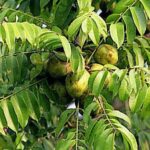Synonyms A. communis, A. incises; Common names Kikwa ki santu Petelo (Kongo), arbre à pain (Fr.), breadfruit

Description
A tree up to 35m tall produces a wide crown. All parts of the tree produce a white, bitter latex. Fruits are nearly spherical, 15 – 30cm in diameter, and either contain large seeds (breadnuts) or are rough, but not spiny, and seedless (breadfruit). The fruiting season may last for 5 months.
Ecology
The tree is occasionally found in villages in Kongo Central. It thrives in a humid climate at low altitudes. The young plants require some shade, but for fruiting, full sun is needed. It dislikes shallow or waterlogged soils. Good drainage is essential. Best growth is obtained in deep moist soils with high humus content and high fertility.
Propagation

The tree can be grown most easily from root suckers. Air layering may also be used or even cuttings, but this is not easy. Root cuttings are taken from mature healthy trees, (indicated by the presence of plenty of latex). These should be taken from roots that lie just below the soil surface, at the end of the dry season. They should be about 2.5cm in diameter and are cut into 20 – 25cm lengths. The cuttings should be planted at an angle in shaded beds and watered frequently. Shoots and new roots may not be produced for several months. Once shoots appear the roots can be divided up and planted in tubes. The cuttings must not be injured. Tar may be used to seal the thickest end. Provide shade over the cuttings. Transplant when shoots are 25 – 30cm long. This is normally after 14 months. Growth is rapid.
Management
Fruits are harvested when they turn yellowish and drops of latex appear on the surface. The cut stalk must be immediately covered to stop bleeding.
Uses
The fruit is eaten in Kongo Central and is an important food plant in much of the tropics. Fruit is preferred baked in ashes, or it may be boiled when it becomes like an Irish potato. The fruit, after being cut up and dried, can be powdered and made into flour which, for many recipes, can replace wheat flour. Some people recommend that the fruit should only be picked once it is completely ripe, others just before this. Fruit is normally ready 2 – 3 months from the emergence of the flowers.
The light, soft wood is yellow and said to be resistant to white ants. It is used for making boxes.
The latex can be used for sealing canoes.
Leaves are used as livestock fodder in periods of drought.
The immature seeds of the breadnut are edible after roasting or boiling in water to which salt has been added.
References
Gillet 1927, Hauman 1948, Swaby 1979, FAO 1982, Burkill 1985, Aumeeruddy & Pinglo 1988, Garner & Chaudhri 1988, Verheij & Coronel 1991, Pauwels 1993, Ragone 1997, Pousset 2004
___________________________________________________________________________________________________________
Text and all photos at this article © Paul Letham. The professional background and contact information of the author of this article, can be found here.
.





